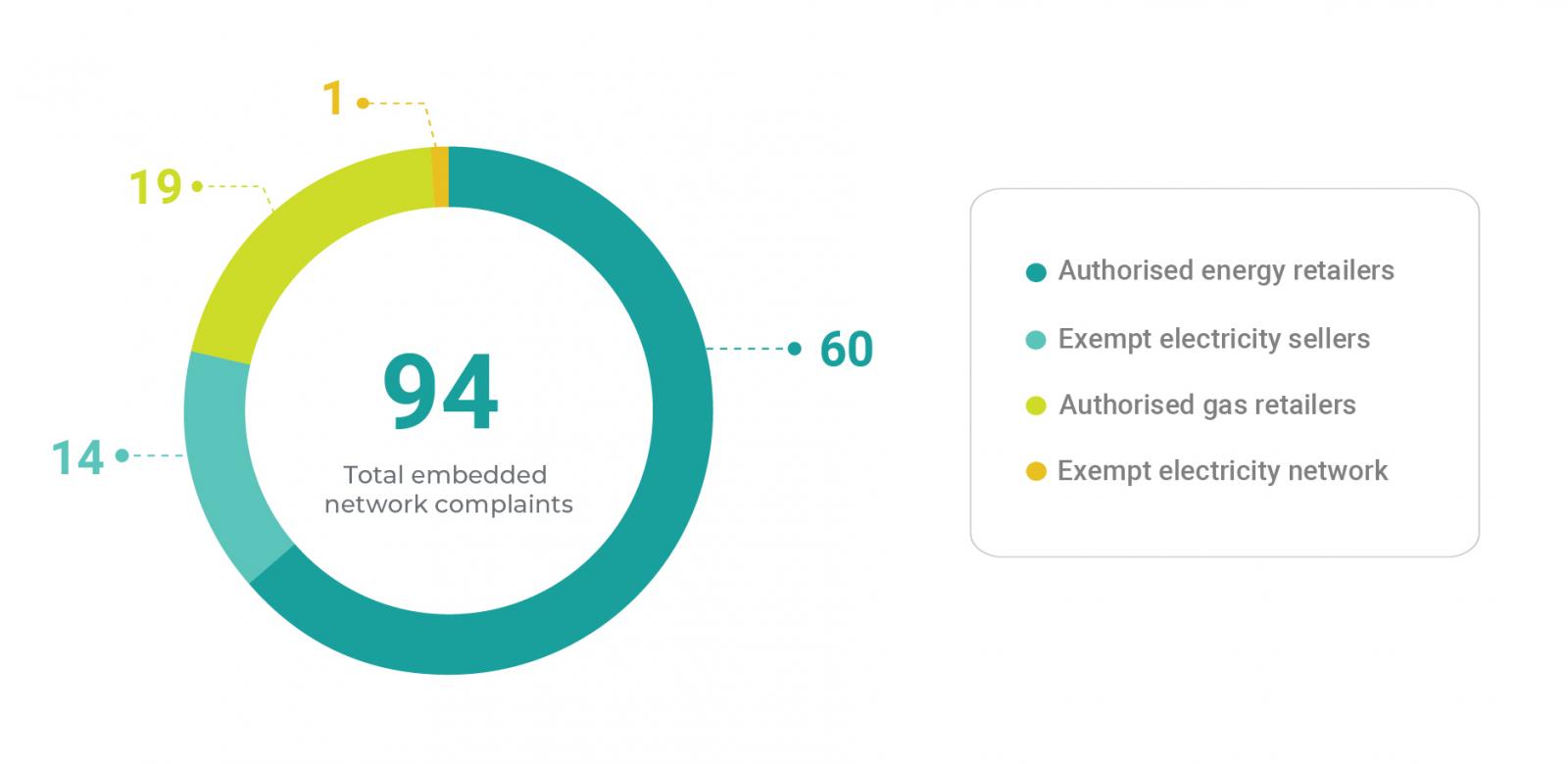-
Home
-
Publications and submissions
-
Reports
-
EWON Insights
-
EWON Insights Oct-Dec 2021
- Embedded network complaints and case studies
Embedded network complaints and case studies
This quarter EWON opened 94 complaints from embedded network customers. These customers complained about the following range of energy service providers:
- authorised energy retailers: 60
- authorised gas retailers: 19
- exempt electricity sellers: 14
- exempt electricity networks: 1
EWON closed 104 complaints from customers whose electricity or gas (including hot water) is supplied through an embedded network.

For the top 10 core issues for embedded network complaints closed this quarter click here.
For the top 10 issues for embedded network complaints closed this quarter click here.
Embedded network customers don’t receive the same protections as other customers
Generally, electricity bills are made up of three major elements: wholesale energy costs, network charges and retail costs. In most cases, customers do not see these costs itemised separately on their electricity bill. Instead, these charges are bundled together into a single retail tariff, which in turn is often comprised of a rate for the energy consumed by the customer and a separate fixed daily charge.
In return for paying network charges, a distributor has several important obligations to customers that are connected directly to the network and covered by the deemed customer connection contract. The NERR clarifies the protections consumers receive through their relationship with distributors. These include:
- distributor service standards and guaranteed service level schemes
- fault reporting and correction
- provision of electricity information
- notice of interruptions
Embedded network customers also pay network charges that are passed through to them by the embedded network operator from the parent connection point to the embedded network. These external network charges are based on a shadow price, which means that embedded network customers often pay the same network charges as customers connected directly to the network. However, an embedded network customer is not covered by the network service provider’s deemed customer connection contract. This also means that the customer is not covered by the obligations a distributor has to its customers, including notification requirements for interruptions, service standards and access to guaranteed service level schemes.
This situation means that if a network event interrupts the supply of electricity to the embedded network, residents and small businesses within the embedded network will not be covered by guaranteed service levels and will not be able to claim for losses associated with the event. This also means that embedded network customers may be left financially disadvantaged compared to customers who are affected by the same network event but are connected directly to the network and therefore benefit from these general protections.
Case Study: Embedded network customer unable to claim compensation for losses after 8-day power failure
In July 2020 a customer complained to EWON that he had experienced a power outage due to a transformer failure within the broader electricity network, which affected many customers in the area. The outage lasted eight days. The customer contacted the licensed network provider and requested it provide an electricity generator for his residential building so that residents could run some appliances. The network’s customer service representative told the customer he could submit a claim to the network for compensation for food wastage if the outage lasted several days. After the power was restored, the customer submitted a claim to the licensed network provider. The claim was declined because the customer lived in an embedded network. EWON advised the customer that as he was not covered by a customer connection contract with the licensed network provider, he could only make a claim to his embedded network operator.
The customer returned to EWON after making the claim for losses caused by the unplanned outage to the embedded network operator. The embedded network operator had also declined the customer’s claim. EWON referred the customer’s complaint to the embedded network operator at a higher level. The embedded network operator provided EWON with the following reasons why the claim could not be taken further:
- The electricity outage was caused by the fault at the network substation and not within the embedded network, so the incident was outside the control of the embedded network.
- The embedded network operator did make a group claim on behalf of the customers within the embedded network, but the claim was declined by the licensed network provider.
- An individual claim could not be made on behalf of the customer to the licensed network provider as the incident was outside the regulated reporting period.
EWON contacted the embedded network provider to obtain more information about the handling of the customer’s claim. The embedded network provider confirmed that the claim was initially rejected because the cause of the outage was an electrical storm, and the operator could not make a claim to the licensed network provider on behalf of the affected residents. This was due to the nature of the connection contract between the licensed network provider and the embedded network operator. The embedded network operator did offer to provide the customer with a credit of $150 due to the lack of information provided in response to the customer’s initial claim.
The customer complained to EWON again in November 2020. The customer advised that the network transformer that was replaced nine months earlier caught fire and caused a second electricity outage event in the building. The customer made a claim for $400 due to food spoilage and was again referred by the embedded network operator to make the claim directly to the licensed network provider. EWON referred the matter to a higher level and the embedded network operator contacted the customer and apologised for providing incorrect information. The embedded network operator offered to include the customer’s claim in the group claim it was making to the licensed network provider following the event.
EWON contacted the embedded network operator again to follow up on the outcome of the customer’s claim. They advised that an explanation for the network event had not been received from the licensed network provider. The embedded network operator offered the customer a credit of $150 due to the customer service issues he experienced following the event. The embedded network operator also agreed to support the customer’s claim to the licensed network operator and to seek reasons for any decision. The customer accepted this outcome to the complaint about the embedded network operator.
The customer again returned to EWON when his claim to the licensed network provider was declined on the basis that he was an embedded network customer. EWON obtained the claim information from the embedded network operator and reviewed the customer contract for both the embedded network operator and the licensed network provider. EWON provided the customer with additional information and acknowledged that the customer was in a situation where they were unable to claim further for unplanned network outages.

